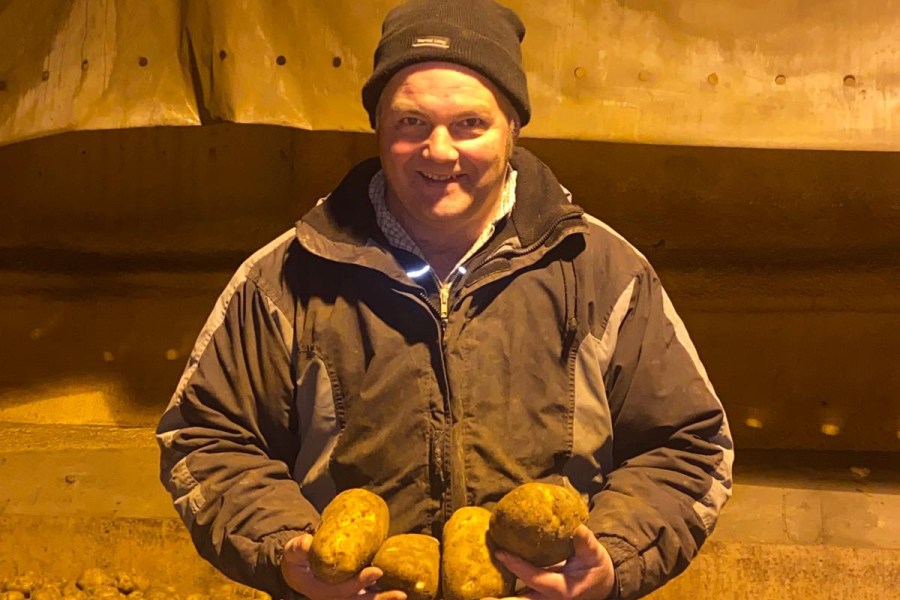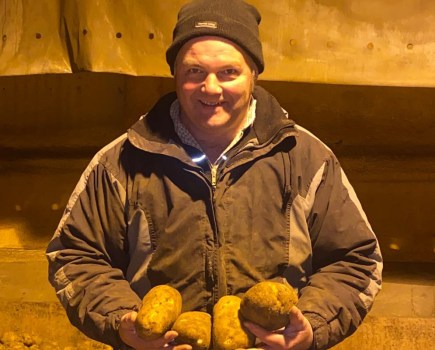by Andrew Wilson
Taties get a bad press when it comes to soil. If we were to assume nothing had changed since the ‘bed-till to death and blather everything with Temik’ days of the 1990s, perhaps it’d be justified, but time moves on.
During the past 25 years much has changed – we’ve lost a lot of chemical tools, while diesel, machines, time and risk have all escalated, but we’ve adapted and we’re still here.
So what’s changed? Well way back when, we ploughed taty (this is Yorkshire!) land generally after we’d finished lifting the previous year’s crop – in late October and November depending on muck availability and beet lifting. It then slumped over winter, was superflowed lots of times and sometimes ploughed again, ridged up, bed-tilled twice, usually while applying a nematicide, separated and planted. Crops grew and it worked… mostly.
There have been many changes, but the situation now is rather different. I take the view that a nematicide kills the bad stuff but in doing so also kills the good soil-life too – which invariably doesn’t recover as quickly as the undesirables – so we use them as a last resort. My strategy now is towards longer-term soil health, better variety choices, and if at all possible, boosting natural defences.
This starts now in the previous summer. We’ve grown cover crops for 15 seasons and made a few mistakes in that time, but also found what consistently works well. Radish, oats, vetch and buckwheat has become our most used seed mix, almost always direct drilled. A field walk pre-drilling of the cover crop is time well spent to ascertain weed pressure, likely nematode threat, and any volunteer potatoes that may be present.
Muck of many kinds is applied depending on what’s available and where it is. Soil testing is much more detailed and rigorous and gives a good base from which to work, from both a nutrition and nematode perspective. Generally, we’ll desiccate our covers in February and top them a week or so later, so that the physical organic matter doesn’t bother potato planting machinery.
Quite by accident in 2012, we discovered that a tined cultivation a day or so before the plough in spring made a huge difference to soil workability and dramatically reduced the need to till, which saves a lot of time, fuel, metal and worms. Consequently, we now bed-till only about a quarter of our total potato area; row condition is better as is tuber quality and saleable yield.
This slightly gentler approach also aids harvest trafficability, which in turn helps the following wheat crop get away in good order. I’d like to say having the physical organic matter in the row rather than buried in an anaerobic layer underneath aids drainage and water retention, but it’s not an easy thing to measure.
Pollinator strips were yet to be invented in the 90s but are commonplace now. The habitats these provide for beneficial insects are important in reducing risk to current and subsequent crops by disease-carrying aphids.
A sea of acronyms has appeared in recent years, particularly if one were to consider regenerative potatoes. VESS, STIR, EIQ, OM, SMDs are all part of the potato language of the 2020s. The humble spade is still the gaffer though, and the most important tool in the box.
So where are we at with other crops this year? Winter barley varies from almost acceptable to don’t ask; spring oats are about normal if we ignore the lack of straw; wheat so far is mediocre but could be worse.
Spring barley has surprised and impressed in equal measure, yielding comfortably over 7t/ha of grain and nearly 3t/ha of straw on heavy land, and about a sixth less in both cases on lighter land. Growing costs are much lower than second wheat and grassweed control is much better, so change is afoot there.
I was lucky that we cultivated heavy land last August and destroyed the cover early enough for the land to be drillable in early March, with its fertiliser under it from the start. Had a bare stubble been left over winter, the barley would have been sown later and likely been a write off.
Beans were desiccated a month ahead of usual and seven weeks ahead of last year. In June they looked like they’d be crop of the season, but now they look like a school report that reads ‘could do better’,
In part, this is because winter beans don’t like wet feet, and the resulting thin patches have let blackgrass in. I’ve dallied with the idea of less winter and more spring beans but shied away due to the difficulty in establishing them in good time.
I think we’ll do some cultivation work this summer while it’s dry, and hope this speeds up drainage and soil warming in spring, ready for spring beans as early as possible after Christmas. This’ll include some ploughing; the best defence against any threat is a strong and competitive crop.
Sugar beet has a question mark over it again. My gut feeling is we’ll stick with it but likely at a reduced level. Vining peas will now follow beet in preference to spring oats as an entry to a first wheat, in an attempt to facilitate an increase in average return across our rotation and reduce risk. In time they might replace beet, who knows?
A wise friend once said about cattle, ‘sometimes you buy em for nowt, feed em for nowt, and sell em for a fortune, and sometimes you do the opposite, you have to focus on the average else it’ll make you bad.’
He’s absolutely right – if I focus on doing more of what consistently works come hell or high water, and do less of what always brings disappointment, I reckon we’ll be ok.
This article was taken from the latest issue of CPM. Read the article in full here.
For more articles like this, subscribe here.
Sign up for Crop Production Magazine’s FREE e-newsletter here.




